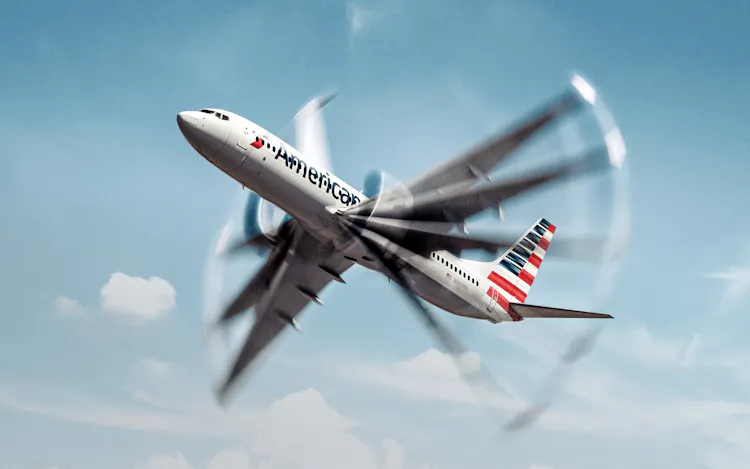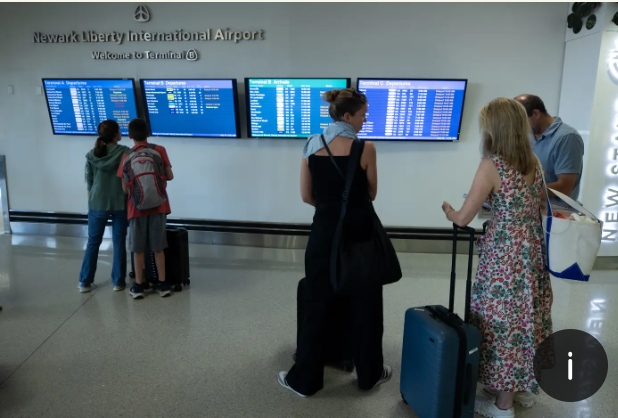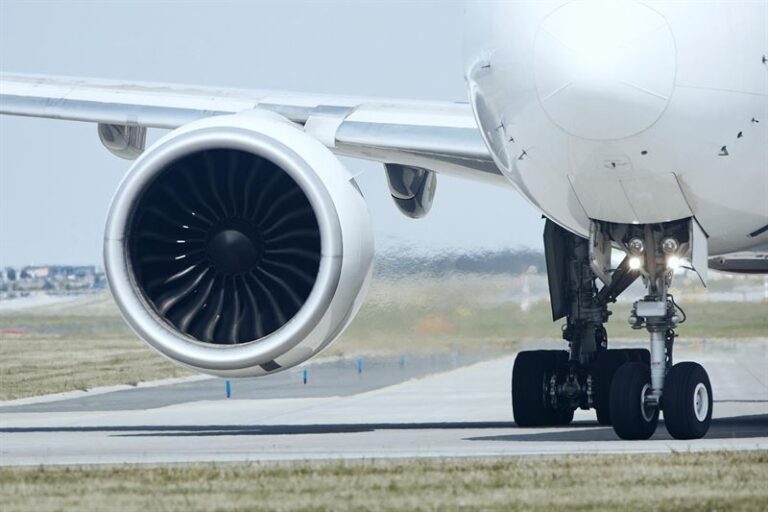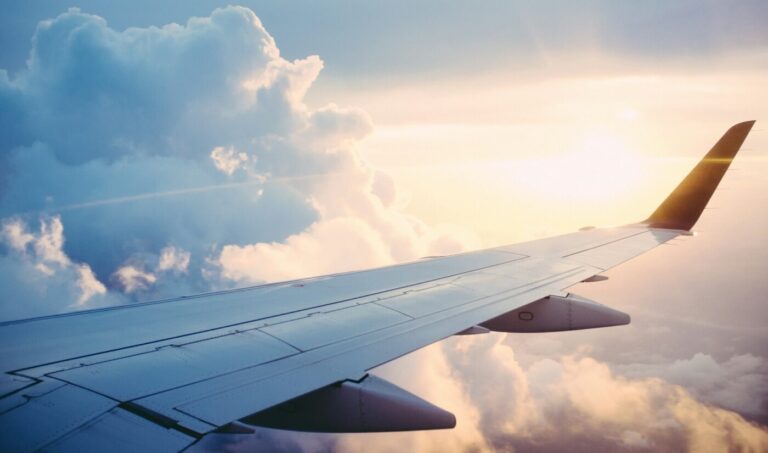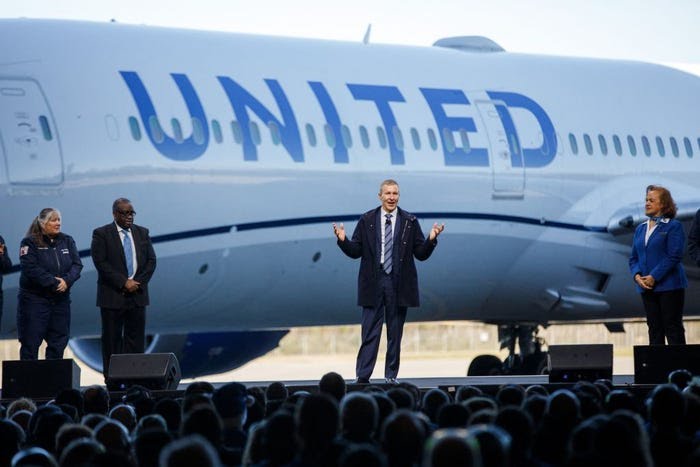Why Is American Airlines So Infuriating?
With its industry reeling, the Fort Worth-based airline giant is quietly betting that diminished competition will keep passengers coming—even as they grumble about the carrier’s poor service, late arrivals, and the jam-packing of its flights amid the pandemic.
Winding its way to the global headquarters of American Airlines, Skyview Drive passes carefully landscaped patches of drought-resistant grasses, trees, and cacti just south of DFW airport. One sunny, 90-degree morning in August, thousands of parking spaces sit empty in the garage across from a gleaming new office building, Skyview 8. Opened last fall as part of a $350 million project to expand the corporate campus, the building now looks like a monument to the optimism that pervaded the airline industry before the pandemic. Inside, a three-story-high ceiling over the circular lobby resembles a giant jet turbine. Above the cafeteria hangs a long, twisting white sculpture built from fan blades by employees at the airline’s Tulsa maintenance center. The piece, Tulsa Vertere, is meant to evoke the swirling vortices of air that trail off the wingtips of a plane in flight.
Though the building was designed to accommodate almost six thousand workers, on this day only about five hundred are working on-site. Chairman and CEO Doug Parker, who just the week before joined other airline executives in Washington to lobby Congress for another round of federal bailout funds, eases back into his chair in a glass-walled conference room overlooking the atrium. “It’s a full-blown crisis,” he says of the industry’s recent collapse. “I don’t think about much else.”
Parker, who was CEO of Tempe, Arizona–based America West Airlines on September 11, 2001, has seen his share of ups and downs in the industry. He came up as a numbers guy, first as a financial planner at American in the eighties, then as a vice president at Northwest (now Delta), then CFO, and finally as CEO at America West. It was a famously volatile period in the industry, as old airlines went out of business or consolidated, and new ones emerged following federal deregulation in 1978. Parker was ten days into his CEO job at America West on 9/11, and if it weren’t for the government loan he ended up securing, the airline would have gone out of business. Instead, he positioned the business to be acquired by US Airways four years later and landed himself in the CEO role of the larger company. Eight years after that, in 2013, he pulled off the same trick when American and US Airways merged, this time landing himself in one of the most powerful positions in the airline game anywhere in the world.
By then, all the consolidation had reduced competition to the point that just four airlines—United, Delta, American, and Southwest—accounted for more than 80 percent of commercial air travel in the United States. Diminished competition resulted in higher prices and, from most carriers, worse customer service. But it also ensured more reliable profits for each of the big four. And for years, there was no louder cheerleader for the idea that the industry had finally sorted itself out than Parker. He wasn’t shy about publicly professing that his company would never lose money again, even in an economic downturn. “We’ll have good years and bad years, but we won’t have disasters,” he said during a panel session at one industry conference in 2017. “We won’t go through the kinds of ebbs and flows we’ve had in the past. Certainly, we’re still cyclical, but the downtimes are going to be a lot better.”
That attitude—along with billions in annual profits buoyed by low fuel prices—does much to explain America’s decision to pursue billions in spending, while piling up vast debts, in recent years. Parker bet that, if his read on the industry’s stability was right, America’s steady profits would remain plentiful enough to keep its planes flying, keep its creditors happy, and keep billions in cash on hand in case of emergency.
Only, the good times didn’t keep rolling. And the magnitude of the bad times that arrived with COVID-19 was unprecedented. All the airlines saw their business collapse this year. In the first week of April, at the height of the pandemic lockdowns, America had twice as many cancellations as new tickets sold. Early on during the pandemic, the airline was losing about $70 million each day.
By summer, it managed to reduce that number to $30 million daily. Slashing the flight schedule, retiring some planes, and laying off 30 percent of its corporate management and support staff was a start. Skyview 7, a 90,000-square-foot IT support building that sits across a creek from Skyview 8 and opened at the same time, was shuttered, and its remaining staffers were reassigned to offices elsewhere. Construction was also halted on Skyview 6, a planned $250 million hotel complex intended to house American workers in town for training sessions. The building’s unfinished steel frame quietly towers in full view from Skyview 8’s central atrium and Parker’s desk—a fitting symbol of the uncertainty into which a global pandemic unceremoniously thrust the airline industry. raveling the skies used to be glamorous and adventurous and America trades roots in early-day aviation. According to the company’s official history, the first American Airlines flight took place on April 15, 1926, when a pilot named Charles Lindbergh carried a planeload of mail from St. Louis to Chicago. A little more than a year later, Lindbergh achieved worldwide fame when he successfully made the first solo nonstop transatlantic flight.
Yet the actual birth of American Airlines has more to do with numbers-driven mergers and acquisitions than feats of derring-do. The central figure of the company’s inception isn’t a hotshot young pilot. It’s an accountant named C. R. Smith, a Texan who rose from the rank and file at a small Fort Worth airline, Texas Air Transport, that was just one of more than eighty small companies that eventually merged to become American. Smith was tapped as president of the new airline in 1934 and led its transformation from carrying mail to serving passengers. In his 34 years as president of the business, he also introduced the first airline lounge system, the Admirals Club, and a computerized passenger reservation system, Sabre, developed with IBM.
It wasn’t until 1979 that Dallas–Fort Worth leaders convinced Americans to relocate to North Texas (it had been based in New York since 1939) by building a headquarters south of DFW Airport, which had opened just five years earlier. Lower rent and other operational costs in Texas, as well as DFW’s more central location within the country, made the move a smart decision for Americans. It was a boon for Texas that led to other major corporate relocations and helped the state become a global business hub.
After mostly thriving during the eighties and nineties, Americans bought TWA right before 9/11 and ended up shuffling through the aughts, finally being forced into bankruptcy in 2011, a victim of the Great Recession. That’s when Doug Parker managed to swoop in and orchestrate his $11 billion merger with US Airways. It was the last of the major airline consolidations and turned America into the world’s largest passenger carrier.
By all accounts, Parker sought to bring a more transparent culture to American business than had existed before—for example, by regularly hosting town hall sessions with employees. He’s fond of parroting legendary Southwest Airlines founder Herb Kelleher’s management philosophy holding that if the company takes care of its employees, its employees will take care of the customers. He’s also emulated Kelleher’s fondness for dressing up in outrageous Halloween costumes. Last year Parker was Billy Ray Cyrus as he and other executives performed “Old Town Road” for employees at the corporate headquarters. Another year he was a tambourine-toting Boy George jamming to “Karma Chameleon.”
Perhaps it’s not surprising that Parker’s efforts to build a fun and open culture around the workplace have never quite trickled down to customers. After all, when US Airways was under his watch, that airline tried charging for soft drinks, water, coffee, and tea amid the Great Recession. (Parker reversed course when other airlines failed to follow his lead and customers complained about the nickel-and-diming.)
Of course, Parker has hardly been the only airline leader squeezing passengers over the past decade. Both Delta and United have reduced the cushioning of their coach seats and the space between rows in recent years. But American outdid them both in 2017 when it announced the seating arrangement on its new Boeing 737 Max jets. The standard distance between seat backs in the economy section was to be 30 inches, a 1-inch reduction, and several rows would be just 29 inches apart. American argued that its slimmer (read: less-padded) seats would make the difference negligible, but the company quickly reversed course on the 29-inch plan over howls of protest from customers and some employees.
Likewise, the myriad additional fees travelers encounter nowadays when booking were not solely American’s invention. Ryan Buell, an associate professor at Harvard Business School who studies customer experience, points to the rise of online booking sites as a key driver of these changes. As search results increasingly showed customers ultra-low fares from budget carriers such as Spirit and Frontier, the legacy airlines needed to compete. They reduced the services and amenities that previously came along with a standard ticket and offered restrictive “basic economy” rates. From a cynical perspective, it looked like the airlines were simply boosting their bottom lines. (“We’ve become accustomed to what we think we should get from the airline, and the airline has moved the goalposts,” Bue
